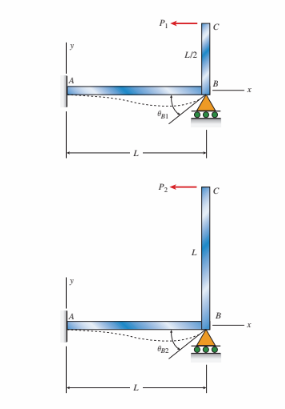Structure 1 with member BC of length L/2 has force P1 applied at joint C. Structure 2 with member BC of length L has force P2 applied at C. Both structures have constant flexural rigidity EI. The required ratio of the applied forces P1/P2 so that joint B rotations ?B1 and ?B2 are equal is approximately:
(A) 1
(B) 5/4
(C) 3/2
(D) 2

(D) 2
You might also like to view...
The Sun is
a. a star which generates its own energy. b. 1 AU from Earth. c. visible by its own light emission. d. All of the other choices are correct.
Two long wires are parallel to each other. One wire carries a current directed due east and the other carries a current of the same magnitude, but directed due west. Which one of the following statements concerning this situation is false?
a) The magnetic field in the plane of the wires at the midpoint between the two wires is equal to zero tesla. b) The magnetic forces due to the currents carried by the wires causes the wires to move apart. c) If you are looking toward the west along the wire carrying the current toward the west, the magnetic field lines are directed clockwise around the wire d) The magnetic field produced by each wire has its greatest magnitude outside, but near the surface of the wire.
A charged particle (q = ?8.0 mC), which moves in a region where the only force acting on the particle is an electric force, is released from rest at point A. At point B the kinetic energy of the particle is equal to 4.8 J. What is the electric potential difference VB ? VA?
a. ?0.60 kV b. +0.60 kV c. +0.80 kV d. ?0.80 kV e. +0.48 kV
A 1.0-mol sample of an isotope is decaying with a half-life of 28 y. After 61 y, how many moles of this isotope are left and what is its activity in Bq?
What will be an ideal response?